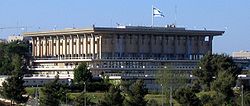Parliamentary system

A parliamentary system of government means that the executive branch of government has the direct or indirect support of the parliament.
Parliamentary systems often work where the head of government is the leader of the political party with the most members in the parliament.
This support is usually shown by a vote of confidence. A balanced relationship between the executive and the legislature in a parliamentary system is called responsible government.
The separation of powers between the executive and law making branches is not as obvious as it is in a presidential system. There are different ways of balancing power between the three branches which govern the country (the executive (or ministers), the law makers and the judges).
Parliamentary systems usually have a head of government and a head of state. They change after their terms are over. The head of government is the prime minister, who has the real power. The head of state may be an elected president or, in the case of a constitutional monarchy, hereditary.
Examples of a few countries which practice parliamentary systems are India, Italy, Japan, Germany, and Latvia. Parliament is different in every country.
Parliamentary System Media
The Palace of Westminster in London, United Kingdom. The Westminster system originates from the British Houses of Parliament.
The Reichstag Building in Berlin, Germany. The Consensus system is used in most Western European countries.
Jatiya Sangsad Bhaban, parliament building of Bangladesh
Sansad Bhavan, parliament building of India









